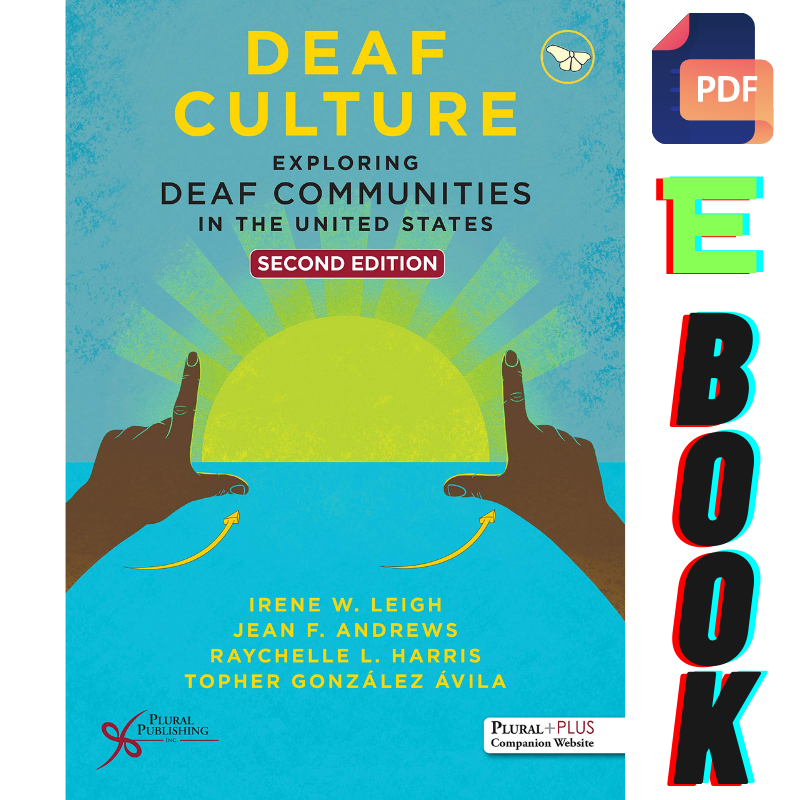Deaf Culture Exploring Deaf Communities in the United States 2nd Edition
Deaf Culture: Exploring Deaf Communities in the United States 2nd Edition is a comprehensive and engaging introduction to the diverse and vibrant world of Deaf culture. Written by four authors with extensive experience in Deaf studies, this book critically examines how Deaf culture fits into various domains of life, such as education, psychology, technology, legal issues, cultural studies, and the arts. The book also highlights the complex and diverse identities within Deaf communities, such as Deaf Persons of Color, DeafDisabled, and DeafBlind. With updated information, new chapters, and a reader-friendly approach, this book is an essential resource for anyone who wants to learn more about the history, language, and culture of Deaf people in the United States.
Learning American Sign Language 2nd Edition
Detailed Summary of Deaf Culture Exploring Deaf Communities in the United States 2nd Edition
Deaf Community: Past and Present
This chapter explores the rich history and diverse demographics of the Deaf community in the United States. It explains that the Deaf community is not monolithic but comprises various subgroups, including DeafBlind individuals, late-deafened adults, and hard-of-hearing persons. Each subgroup has unique experiences and needs. The chapter highlights key historical events such as the Deaf President Now (DPN) movement at Gallaudet University, which was a pivotal moment for Deaf empowerment and visibility.
Causes of Being Deaf and the Auditory Field
The book discusses various causes of deafness, including genetic factors, illnesses, and environmental influences. It addresses the medical versus cultural views on deafness, emphasizing a shift from seeing deafness as a disability to recognizing it as a unique cultural and linguistic identity. This chapter also covers the field of audiology and advancements in hearing technology, providing insights into the benefits and limitations of devices like hearing aids and cochlear implants.
American Sign Language (ASL)
ASL is central to Deaf culture and identity. The book details the structure, grammar, and syntax of ASL, contrasting it with spoken English. It highlights the importance of ASL in Deaf education and everyday communication. The chapter also addresses misconceptions about ASL and emphasizes its recognition as a fully developed language. The role of Deaf educators and the contributions of Deaf scholars in advancing ASL research are discussed.
How Deaf Children Think, Learn, and Read
This section explores cognitive and educational aspects of deafness, emphasizing the importance of early exposure to sign language. It discusses various educational approaches, including bilingual-bicultural education, which combines ASL and English literacy. The chapter also examines the challenges Deaf children face in mainstream educational settings and the benefits of Deaf-specific programs. Research on the cognitive processes of Deaf learners is presented, highlighting their visual-spatial strengths and unique learning styles.
Deaf Education, Deaf Culture, and Multiculturalism
The book explores the intersection of Deaf culture with other cultural identities, such as race, ethnicity, and gender. It discusses how these intersecting identities influence the experiences and perspectives of Deaf individuals. The chapter also addresses the role of multiculturalism in Deaf education, advocating for inclusive practices that respect and celebrate diversity within the Deaf community.
Deaf Identities
Deaf identity is multifaceted and can include various aspects such as cultural, linguistic, and social identities. The book examines how Deaf individuals develop their identities and the factors that influence this process. It discusses the concept of “Deaf Gain,” which views being Deaf as an advantage rather than a loss, and the importance of community and cultural connections in shaping a positive Deaf identity.
Navigating Lives
This chapter delves into the everyday lives of Deaf individuals, exploring their social interactions, family dynamics, and community involvement. It discusses the experiences of growing up in Deaf versus hearing families and the impact of these environments on identity formation. The chapter also addresses issues related to accessibility, communication, and the social integration of Deaf individuals in various settings.
Technology and Accessibility
Advancements in technology have significantly impacted the Deaf community. The book covers a range of technologies, including hearing aids, cochlear implants, video relay services, and captioning. It discusses the benefits and controversies associated with these technologies and their role in enhancing accessibility and communication. The chapter also highlights ongoing advocacy efforts to improve accessibility in media, workplaces, and public spaces.
Deaf People and the Legal System
The book examines the interaction between Deaf individuals and the legal system, highlighting issues related to legal rights, accessibility, and advocacy. It discusses the importance of ensuring effective communication in legal settings, the role of interpreters, and the legal protections afforded to Deaf individuals under laws such as the Americans with Disabilities Act (ADA). The chapter also addresses challenges and successes in achieving equal access to justice for Deaf people.
Arts, Literature, and Media
Deaf culture has a rich tradition of artistic and literary expression. This chapter explores the contributions of Deaf artists, writers, and filmmakers to the broader cultural landscape. It highlights the importance of visual storytelling in Deaf culture and the unique perspectives that Deaf creators bring to their work. The chapter also discusses the representation of Deaf characters and stories in mainstream media and the impact of these representations on public perceptions of Deafness.
Advocating and Career Opportunities
Advocacy and self-advocacy are crucial components of the Deaf community’s efforts to achieve equality and inclusion. This chapter discusses the history of Deaf advocacy, including major milestones and ongoing efforts. It also explores career opportunities for Deaf individuals, addressing barriers to employment and strategies for overcoming them. The chapter highlights the achievements of Deaf professionals and the importance of promoting Deaf leadership in various fields.
Final Thoughts on Deaf Culture and Its Future
The book concludes with reflections on the future of Deaf culture, considering how it may evolve in response to changing societal attitudes and technological advancements. It stresses the importance of preserving Deaf culture and ASL while embracing new opportunities for inclusion and empowerment. The chapter also discusses the ongoing challenges and opportunities facing the Deaf community, emphasizing the need for continued advocacy and education.
Overall, “Deaf Culture Exploring Deaf Communities in the United States” provides a comprehensive and nuanced understanding of the Deaf community, celebrating its rich culture, resilience, and contributions to society.
Frequently Asked Questions (FAQs)
1. What is the Deaf community, and who does it include?
The Deaf community is a diverse group of individuals who are deaf or hard of hearing. It includes those who use American Sign Language (ASL) as their primary mode of communication, as well as those who may use other forms of communication. Subgroups include DeafBlind individuals, late-deafened adults, and hard-of-hearing persons, each with unique experiences and needs.
2. What is the significance of American Sign Language (ASL)?
ASL is a fully developed, natural language with its own grammar and syntax, distinct from English. It is central to Deaf culture and identity, serving as the primary means of communication for many Deaf individuals. ASL is essential for Deaf education and social interactions within the Deaf community.
3. How do Deaf children learn and develop language skills?
Deaf children benefit significantly from early exposure to sign language, which supports their cognitive and linguistic development. Bilingual-bicultural education models that incorporate both ASL and English literacy are effective in fostering language skills. Visual-spatial learning strengths are also emphasized in Deaf education.
4. What are the main causes of deafness?
Deafness can be caused by a variety of factors, including genetic conditions, illnesses, injuries, and environmental influences. The book discusses both congenital and acquired causes of deafness, highlighting the diverse backgrounds of Deaf individuals.
5. How does technology impact the Deaf community?
Technological advancements have greatly enhanced accessibility and communication for Deaf individuals. Technologies such as hearing aids, cochlear implants, video relay services, and captioning have improved access to information and communication. However, there are ongoing discussions about the benefits and controversies of these technologies within the community.
6. What are some key historical events in the Deaf community?
Significant events include the Deaf President Now (DPN) movement at Gallaudet University in 1988, which was a pivotal moment for Deaf empowerment and visibility. Other milestones include the recognition of ASL as a legitimate language and the passage of laws such as the Americans with Disabilities Act (ADA), which protects the rights of Deaf individuals.
7. How does the Deaf community interact with the legal system?
Deaf individuals face unique challenges in the legal system, particularly regarding effective communication and access to legal services. The book discusses the importance of interpreters, legal rights under the ADA, and the ongoing efforts to ensure equal access to justice for Deaf people.
8. What is “Deaf Gain”?
“Deaf Gain” is a concept that reframes being Deaf as a valuable and beneficial identity rather than a loss. It emphasizes the unique contributions and perspectives that Deaf individuals bring to society, challenging the traditional view of deafness as a disability.
9. How does multiculturalism intersect with Deaf culture?
Deaf culture intersects with other cultural identities, including race, ethnicity, gender, and sexuality. The book explores how these intersecting identities influence the experiences and perspectives of Deaf individuals, advocating for inclusive practices that respect and celebrate diversity within the Deaf community.
10. What career opportunities are available for Deaf individuals?
Deaf individuals pursue careers in various fields, though they may face barriers to employment due to accessibility issues and societal biases. The book highlights strategies for overcoming these barriers and promoting Deaf professionals, emphasizing the importance of self-advocacy and community support.
11. How does the book address the arts, literature, and media in Deaf culture?
Deaf culture has a rich tradition of artistic and literary expression. The book explores the contributions of Deaf artists, writers, and filmmakers, highlighting the importance of visual storytelling. It also discusses the representation of Deaf characters and stories in mainstream media and its impact on public perceptions.
12. What are the future challenges and opportunities for the Deaf community?
The future of Deaf culture involves preserving ASL and cultural identity while embracing technological advancements and greater societal inclusion. The book stresses the importance of ongoing advocacy, education, and adaptation to ensure that Deaf individuals continue to thrive and contribute to society.
13. How can hearing individuals support the Deaf community?
Hearing individuals can support the Deaf community by learning ASL, advocating for accessibility and inclusion, respecting Deaf culture, and supporting policies and practices that promote equal opportunities for Deaf individuals. Engaging with Deaf-led organizations and events also fosters understanding and solidarity.
These FAQs provide a comprehensive overview of key topics covered in “Deaf Culture Exploring Deaf Communities in the United States,” offering insights into the rich and diverse experiences of the Deaf community.




Reviews
There are no reviews yet.